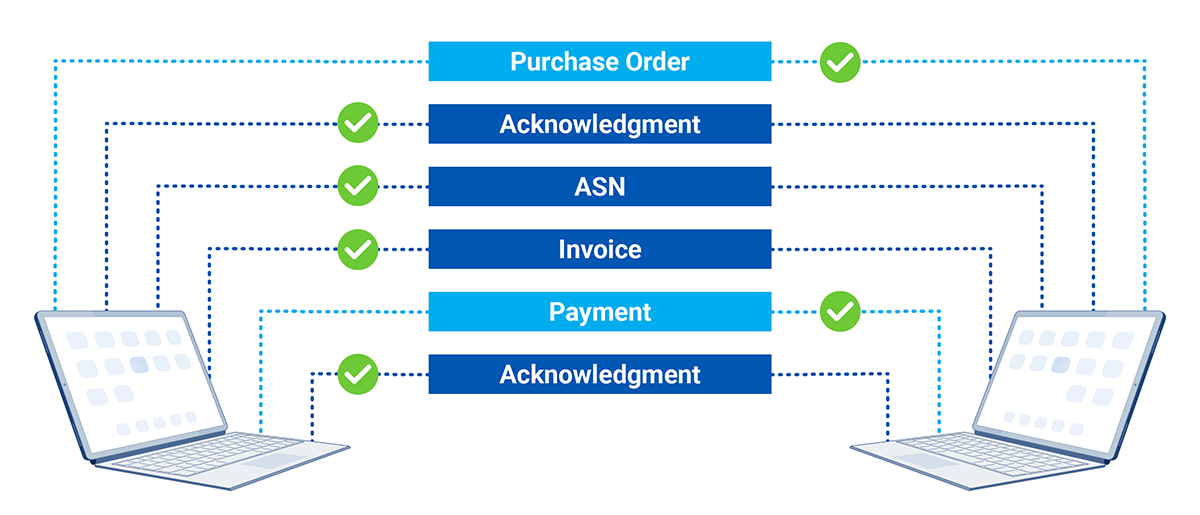The Keys to Completing EDI Testing and EDI Certification

If you want to compete in today's increasingly digital marketplace, you must be EDI compliant, no matter how large or small your organization is.
But while paperless transactions are great for saving trees, they're not without potential challenges. For example, data quality and security issues, different EDI formats, and complex datasets can lead to charge-backs, backlogs, failed transactions, damaged relationships, and more.
Simply being EDI compliant or capable doesn't address any of these issues. That's where EDI testing comes into play.
EDI testing is a combination of connectivity testing and process validation that ensures the smooth exchange of data between EDI-based applications, allowing you to identify issues before they impact the EDI certificate process.
In formulating your approach to EDI testing, this guide can help unlock a faster and more efficient testing strategy that will allow you to complete your partner transactions certifications processes more quickly and start driving revenue faster.
What is EDI Certification?
It can be difficult to add and support new EDI-capable trading partners, especially if you don't follow a specific process for EDI certification.
What is EDI certification? It's the result of successful EDI testing.
It validates that you comply with trading partners' technical and informational requirements and ensures that EDI transactions will flow smoothly between you once you commence trade.
EDI certification also proves trading partners can meet consumer privacy and industry compliance requirements.
For example, healthcare-related businesses must test their EDI transactions to ensure HIPPA compliance.
In Retail, behemoths like Walmart or Amazon have their set expectations for how EDI needs to function.
Certification is one of the most critical steps in EDI partner onboarding and the overall EDI implementation process.
And the faster your company passes muster, the sooner integration solutions will be contributing to revenue generation.
In 2021, 45% of integration experts surveyed said it took between one week and one month to onboard a new supply chain partner, up from 37% the year before. And 42% say it is taking over a month, up from 36% the prior year. These delays directly impact revenue, vendor scorecards, and customer satisfaction.
The root causes for these delays can be found not with poor partner performance, but internally with the companies themselves, where outdated legacy or homegrown applications, overreliance on manual processes, or too much custom code are hindering partner onboarding for over 50% of businesses.
Additionally, the dwindling availability of skilled talent was cited by 37% of respondents as yet another top challenge impacting partner onboarding.
All of these self-created limitations can impact the speed and success of a company's EDI testing process. But there are always ways to improve it.
Passing EDI Testing is the Key to EDI Certification
Virtually every major company demands their trading partners communicate using EDI software.
And most have a detailed EDI certification process to prove you can send and receive EDI transactions according to their specifications.
Retail giants like Walmart clearly outline their requirements for prospective partners in their EDI implementation guide.
To do business with them, you must be capable of the following:
1. Supporting the electronic exchange of a basic document set including:
- 810 Invoice
- 821 Claim
- 816 Address Listing
- 820 Remittance
- 850 Purchase Order
- 864 Text Message
- 997 Acknowledgment
2. Completing EDI testing of the basic document set within six weeks
3. Using Walmart's preferred AS2 EDI file format and maintaining a consistent connection to avoid disruptions in communication
4. Sending an EDI 997 functional acknowledgment no more than 24 hours after receiving a purchase order
Partners that fail to adhere to these guidelines and other SLAs (Service Level Agreements) risk EDI charge-backs or revocation of trading partner status.
Here is a visual representation of EDI testing and EDI certification:

EDI Testing Scenarios
Before you begin testing, you must demonstrate you can exchange data between your EDI software platforms by mapping your EDI transactions.
EDI mapping translates data structures from a proprietary file to a standard EDI format and back again.
Once you've completed the mapping process, you may be required to perform various EDI testing scenarios to achieve EDI certification.
Whether you test in-house with a third-party EDI solution or use a managed EDI service, here are some recommended types of testing. Some are more prevalent in healthcare and other highly regulated industries.
- Integrity testing: Confirms the syntactical integrity of the EDI transaction by testing valid segments, segment order, elemental attributes, and more
- Implementation Guide or requirements testing: Ensures your transactions adhere to your partner's implementation guide, EDI mapping requirements, and specific EDI standards related to HIPPA or B2B gateway requirements. This testing flags transactions that don't comply with internal controls before they're passed to business applications for integration.
- Balancing testing: Confirms your field totals, financial values, and summary level data are balanced. For example, balancing testing would verify that ordered items match the items on the invoice.
- Situation testing: Tests specific inter-segment situations in which if A happens, then B must be populated. This includes validating situational fields based on values or situations found elsewhere in the file. For instance, if an insurance claim is for an "accident" the "accident date" must be present.
- External code set testing: Validates Implementation Guide-specific code sets (and other HIPPA-compliant code sets) ensuring their usage is appropriate for each given transaction.
- Product type or line of service testing: Ensures that any data records specific to product type or line of service are correctly created and processed.
As you complete the required EDI testing scenarios, it is critical to perform end-to-end testing to verify that you can process partner transactions through your backend systems.
Testing requirements are also different from one industry to another, given the unique end-to-end business processes at work.
For example, in manufacturing, Order-to-Cash is the end-to-end processes ecosystem parties want to ensure is working.
In Logistics, it's Load-Tender-to-Invoice.
In other sectors, it is the Procure-to-Pay process.
Regardless of which industry you are in, though, EDI testing and certification is an important part of your ongoing relationship with your important ecosystem business partners.
For instance, if you're testing a purchase order and invoice, first, you'll have a new partner send you a test purchase order.
Then you'll run the transaction through your business process and create the sales order within your ERP, WMS, TMS, etc.
Next, you'll process the order as if you're going to ship the product by creating a packing slip and any other related documents.
Finally, you'll send the invoice to your partner and obtain their signoff on the entire process.
Your EDI Testing Strategy
According to Statista, today's average organization uses 110 software as a service (SaaS) applications. Many are also managing complex infrastructures including legacy systems, information silos, custom apps, and complex datasets.
So it's entirely possible to have a different workflow for each type of EDI document, some of which can take hours, even days.
Performing EDI testing manually exposes you to unnecessary risk and wastes a lot of time.
Not only are you more likely to make mistakes that can result in chargebacks and missed SLAs, but you're also delaying new revenue streams.
An effective, repeatable EDI testing strategy is a better alternative that allows you to start doing business as soon as possible with new trading partners.
EDI automation testing is a critical component of a complete strategy helping to address the typical challenges of EDI related to volume, complexity, and accuracy.
It also encompasses end-to-end testing capabilities, including performance testing, data validation and reporting, and EDI file conversion to standard formats.
Here's what EDI automation testing tools accomplish in a practical sense:
- Process large volumes of data quickly, running EDI tests in a fraction of the time
- Free test engineers to concentrate on test analysis and other critical tasks
- Reduce errors caused by human intervention
- Speed processing and improve report management to reduce transaction turn-around time
- Mitigate risk by identifying business process issues before they impact production
- Slash costs and the time spent on onboarding new trading partners
EDI Testing and Automated EDI Integration Go Hand in Hand
While having a repeatable EDI testing process is essential, leveraging an automated EDI integration platform will help ensure you stay compliant while supporting your entire ecosystem's evolving needs.
The Cleo Integration Cloud (CIC) enables you to address trading partners' EDI compliance requirements proactively while providing end-to-end real-time visibility across your environment, including API, EDI, and non-EDI applications. As a result, technical and business users can discover and correct problems, pinpoint EDI compliance violations, and quickly resolve issues to reduce dropped, late, or inaccurate orders, invoices, ASN, and acknowledgments.
Set Yourself Up for Success
Establishing a robust, repeatable EDI testing strategy will make completing your partner EDI certificate processes a breeze. But testing alone won't ensure your trading partnerships are successful.
Instead, you'll need a comprehensive, integrated approach that leverages real-time insight, proactive management abilities, and visibility across your entire ecosystem.
If you're ready to improve existing partner relationships and drive more revenue, contact us today.

About Cleo
